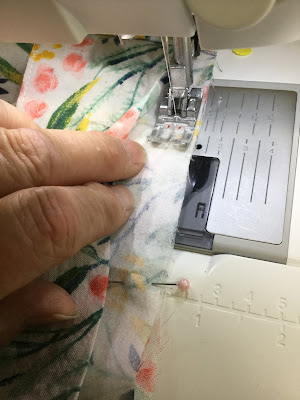 |
| Moto Maxx pants in black and grey scuba |
 |
| That's my grandson on the left. |
I did a test sample in the fabric to see if it would work first. Always test a new idea! And it did work, so now to make the shirt.
I had quite a bit of the grey Polartec Delta, but not much of the apple green, so I decided on stripes for the arms and neckband, but to leave the sleeves uncuffed so I added 2" to the sleeve length. I wanted the green just to be an accent. Polartec Delta is an amazing fabric - it wicks moisture away from the body but keeps you cool and prevents smelly bacteria odors. Perfect for my hot-bodied grandson.
I cut out all my pieces, then planned how I'd put the stripes on the sleeves and measured to see how long the stripes needed to be. And bravely decided on two stripes per sleeve!
I cut the stripes .5" wide
I tried the stripes out on the sleeve to see how it would look.
I marked the stripe ends with pins and drew a line on each sleeve for the first stripe.
Then I applied glue to the back of the first stripes and gently laid them in place just over the line to hide it, being careful not to stretch them.
Once the first stripes were in place, I drew another line .5" away for the second stripe.
When both stripes were in place and glued down, I pinned for extra security and moved to my coverstitch machine. The coverstitch is a stretchy stitch. A long straight stitch might work if you don't have a coverstitch machine, as long as you stretched the fabric slightly as you sewed but it might not be that easy to do with such narrow strips of fabric. Perhaps a zig zag would be better.
It probably would have made my job easier if I'd threaded with a matching thread, but I decided to go for contrast, so it was important to be as accurate within the stripe as possible. You achieve this by concentrating on the front of the foot. Don't look at the needles as you'll stray for sure! Concentrate on the front of the foot.
My coverstitching wasn't perfect, but on a spiral stripe it will be hard to pick out the imperfections! I gave the stripes a quick steam press and then it was just just constructing the shirt. And the Vanguard is such a quick sew! In no time, I had my grandson's shirt ready for him.
The Vanguard Kit is an amazing pattern and probably the children's pattern that I use the most. It will work for girls as well as boys and has so many options in it that each shirt is a unique one. If you don't already have this pattern (or the Moto Maxx) you can get them through my affiliate links below.















































